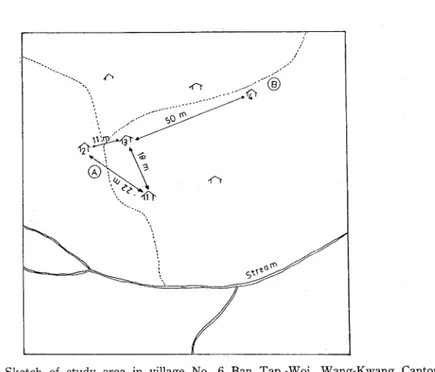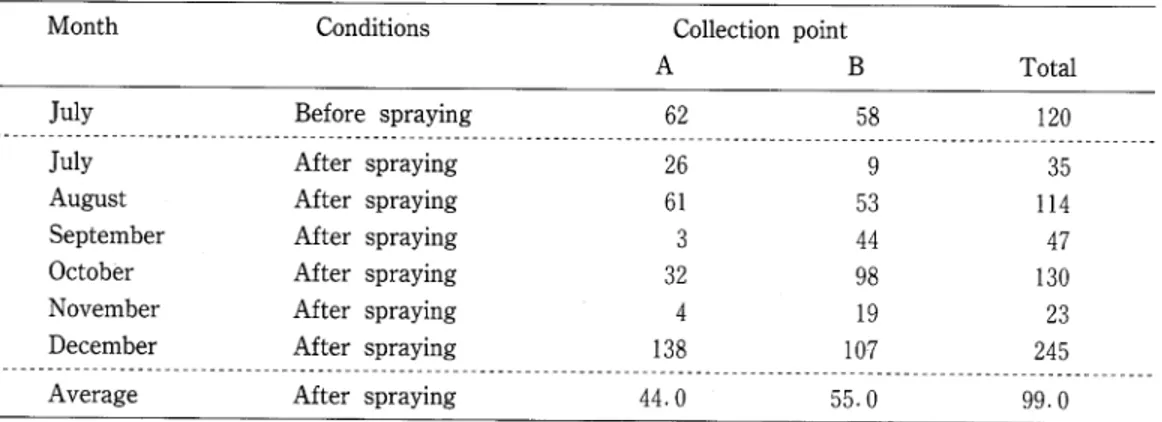A Field Study on the Response of Anopheles dirus to DDT and Fenitrothion Sprayed to Huts in
Phetchabun Province, Thailand
Wannapa SUWONKERD} , Boonserm AMG-UNG2) , Kamolwan RIMWANGTRAKUL1), Somsak WONGKATTIYAKUL^,
Boontap KATTIYAMONGKOOL1' , Udom CHITPRAROP1' and Masahiro TAKAGI3)
1) Malaria Center Region 2, Chiangmai, Thailand
2) Research Section, Malaria Division, C.D.C., Ministry of Public Health, Bangkok, Thailand
3) Department of Medical Entomology, Institute of Tropical Medicine, Nagasaki University, Nagasaki 852, Japan
Abstract: A field study was carried out in a village of Phetchabun Province, Thailand to evaluate the behavioral resistance of Anopheles dirus to indoor residual spraying of DDT and fenitrothion (FNT). Among four experimental huts three were sprayed with 2g and 1g of DDT, and 1g of FNT per m2. Indoor and outdoor human bait collections were performed before and after the treatment for six months. The ratio of indoor biting densi- ty to outdoor one (IBD/OBD) was prominently reduced after the treatment in a hut with 2 g of DDT. The reduction was also ascertained in huts with 1g of DDT and FNT. The reduction on the ratio of indoor resting density to indoor biting density (IRD/IBD) after the treatment suggested presence of the behavioral resistance of the species to those in- secticides.
Key words: Behavioral resistance, Anopheles dims, DDT, Fenitrothion, Thailand INTRODUCTION
Malaria is one of the most important mosquito-borne diseases in Thailand. The Malaria Division, Ministry of Public Health reported 302,674 and 321,508 malaria cases in 1987 and 1988. The major malaria vectors are Anopheles dims (Scanlon and Sandhinand, 1965; Ismail et al, 1974, 1975; Peyton and Harrison, 1979) and An. minimus (Ayurakit- Kosol and Griffith, 1962), and it has been believed that these species have been still susceptible to DDT (Ismail et at., 1975; Nutsathapana et al, 1986). Therefore a main con- trol measure against the vector has been residual house spraying of the insecticide once or twice a year in the country. In 1982 fenitrothion (FNT) was introduced to some areas as another candidate of insecticide. In 1988 a field study was conducted to clarify recent
Received for Publication, January 31, 1990.
Contribution No. 2384 from the Institute of Tropical Medicine, Nagasaki University.
2
response of malaria vectors to DDT and FNT especially focusing the behavioral resistance of An. dims. The results obtained by this study are reported here.
STUDY AREA AND METHODS
The study was carried out from July to December in 1988, in the village No.6, Ban Tap-Woi, Wang-KwangCanton, King Nam-Nao District, Phetchabun Province, Thailand, where any insecticides had never been sprayed for malaria vector control before the study.
The study site was surrounded by a deep forest about 3km far from the nearest village where 430 people were populated. As shown in Fig. 1, four local farm huts, numbered from 1 to 4, were used as the experimental huts. On July 13, 1988 inside walls of three huts, No. 2, 3 and 4 were sprayed with 2g and lg/m2 of DDT and lg/m2 of FNT, respec- tively. The hut No.l was unsprayed as a control hut. Just before and after the treatment, indoor human bait collection in each hut and outdoor one at two points shown in Fig. 1 were conducted monthly in eight successive nights from 18 : 00 to 24 : 00. Fifty minutes human bait collection and ten minutes resting mosquito collection were made hourly in each of four huts. Two human baits, who worked as collectors also, were stationed a col- lection point and rotated everyday. Besides the indoor collections, thirty minutes human bait collection was made hourly at two outside points.
/
/>
-n- ro
<bO(O
U**T '%
Ö>
^
-o
<&
Fig. 1. Sketch of study area in village No. 6 Ban Tap.-Woi, Wang-Kwang Canton, King Nam-Nao District, Phetchabun Province, Thailand.
Ö, Ö : outdoor collection points.
1 :Controlhut 2 :DDT2g/m2 3 :DDTlg/m2 4 :FNTlg/m2
RESULTS AND DISCUSSION
Seasonal changes of total number of An. dims collected outdoor by human baits are shown in Table 1. It fluctuated throughout the experimental period without clear seasonal trend except high density in December. An. minimus and An. maculatus were also caught by the collection. These species also increased in December, and they were not abundant in other months. Total number of An. dims collected for eight successive nights just before the spraying and the average number of the species per eight nights for six months after the spraying were 120 and 99 as the sum of two stations, respectively.
Table 2 shows the indoor biting density (IBD) by human bait collection and its ratio to outdoor biting density (IBD/OBD) before and after the spraying. The ratio in a hut No.
2 (DDT 2g/m2) was 1.384 before the spraying. It reduced prominently to 0.719 on the average after the spraying. The same tendencies were observed in a hut No. 3 (DDT
lg/m2) and No. 4 (FNT lg/m2). The changes of the ratio before and after the spraying were from 0.975 to 0.814 in a hut No. 3, from 0.467 to 0.431 in a hut No. 4. On the other hand it rather increased from 0.600 to 1.150 in a hut No. 1 (control). Therefore, taking in- to account of increase in the ratio in the control hut, it was obvious that many of An.
dims avoided to enter the hut No. 2 after spraying with 2g/m2 of DDT. Avoidance of entering to sprayed huts was somewhat observed in huts No. 3 and 4. It was also sug- gested that the avoidance was the strongest just after the spraying.
Another aspect of behavioral resistance of An. dims, the change of indoor resting behavior, was evaluated. The indoor Testing density and its ratio to Iindoor biting density (IRD/IBD) were examined, and the result was summarized in Table 3| Both of the number and the ratio apparently decreased after the spraying in hut No. 2 an^ 3 in spite of no ac- tual changes in the control hut (No. 1). The average ratios after the spraying in huts with DDT 2g/m2 and DDT lg/m2 reduced to only less than 30% of those before spraying, and the avoidance from walls sprayed was observed continuously throughout the study period.
In the hut of FNT lg/m2 (No. 4), the avoidance was also clearly observed, but did Table 1. Outdoor biting density per eignt nights (OBD) of An. dims before and after the
indoor residual spraying of DDT and fenitrothin (FNT)
Month Conditions Collection point
A B Total
July Before spraying 62 58 120
July After spraying 26 9 35
August After spraying 61 53 1 14
September After spraying 3 44 47
October After spraying 32 98 1 30
November After spraying 4 1 9 23
December After spraying 1 38 1 07 245
Average After spraying 44. 0 55- 0 99. 0
4
a
I
H
P
0
CO I-p 'S 3
%o s
§
Q
PQh-l
i
Q
PQO QCQ
i-i
Q a
Q
§ Q 3
Q
PQ>-i
QPQ O I
Qpq
8-
£
O. v-< O OO T-H
LO CT5 [-- O CO
C£> ^ i-< CM Od
^H O ^-H T-* C-3
oo co LO t>- cxi o.
LO LO LO LO LO Csl
<£> CO ^ Csl CT>
O O O O O
<N1 <0 <NI O ^ 0>
CM Cd CM CO CXI CM
CO I-H ^ 00 -^ CO
^J< CTs Oi O t>- t>- LO -^f OO I>- r-i O>
o o o o csi o
CTi CO CM CM O 00
i-i LO à""* cn LO i-i
t>- CM O O 00 CO
O OO CO
un LO o
O O r-t O> ^^
to C<l LO LO LO OO
*-t [-- LO tO 00
two bfl bfl tX> bJO bJO
c o a a a c
à"g> '£ 'g, '£ 'g, 'g,
<U <D D OJ GJ Q^
^53<3^33^
III§§1,ll
>> Go%£ > u
Z3%8£&
§
bO
I
CD SCD
<
.
-* H
a
2?
IQ
</>
I
1
CJ
à"3
§ S
p
£9p gj Qa
§
§s
QS
QPQ Q S
Q S
Q a p a
pp^
£
CD ^f CO O CTi Ol
OO O O- LO CJD LO
O CO ^^ CO t>- Cvj
T-^ O O O O 1-n
CO C-~ CD LO O ^
cr> r-H oa LO ^r co
t-^ CTi CM CO LO T-H
O T-H CS]' r-H CO
C£> ^f OO T-H CO O i-i 00 Od t>- CO CTi
CM -^ m oo
oo o o t-
^O ro -xF -^f
O CM
CVJ CXI
i-i CM
O O O O O O
CM t- o- -^ co -^
r_| ^H ^H "^
OO ^ LO OO CO LO
co ,-i LO cr> -^ 03
^^ LO Cst O3 »-H CD
o o o o o o
t^ I>- -^f C^ LO LO
tuo bo bo bo bo bo c c a G n n
>; à">, à">, à"& à">, à">,
cti rt rt rt cd cti
}_, VH 5-i 5-i VH VH
ft p^ O, A, p, p<
C/3 CO CO 03. 03 CO
Q^ <U C^ CU C^ CJ
5<«j^:^^
«I*II
*1111§
"73 2 <jj <-> ° ^
S<c/}O^i Q
<u bo S i
not last long. The ratio decreased just after the spraying to approximately 33% of before the spraying. It recovered month to month, and in October, three months after the spray- ing, it showed the equivalent ratio of that before the spraying as shown in Table 3. A similar result was reported by Nutsathapana et al. (1986) about An. minimus.
These results strongly suggest that An. dims in the study area shows clear behavioral resistance to DDT, even if it was sprayed with a concentration of Ig per square meter, and that the behavioral resistance was shown not only by avoiding to enter sprayed houses but also by avoiding to rest on the walls sprayed. Thtf behavioral resistance was also observed to FNT, but the resistance may not be so strong as that to
DDT in An. dims.
ACKNOWLEDGEMENTS
We wish to thank all collectors who helped us during this study. We are grateful to Prof. Y. Wada, Department of Medical Entomology, Institute of Tropical Medicine, Nagasaki University, for critical reading the manuscript.
REFERENCES
1 ) Ayurakit-Kosol, L. & Griffith, M. E. (1963): Progress toward malaria eradication in Thailand.
Proc. 9th Pacific Sci. Congr., 17, 122-136.
2) Ismail, I. A. H., Notananda, V. & Schepens, J. (1974): Studies on malaria and response of Anopheles balabacensis balabacensis and Anopheles minimus to DDT residual spraying in Thailand.
Part 1; Pre-spraying observations. Acta. Trop., 31, 129-164.
3) Ismail, I. A. H., Notananda, V. & Schepens, J. (1975): Studies on malaria and response of Anopheles belabacensis balabacensis and Anopheles minimus to DDT residual spraying in Thailand.
Part 2; Post-spraying observations. Acta. Trop., 32, 206-231.
4 ) Nutsathapana, S., Sawasdiwongphorn, P., Chitprarop, U. & Cullen, J. R. (1986): The behavior of Anopheles minimus Theobald (Diptera: Culicidae) subjected to differing levels of DDT selection
pressure in northern Thailand. Bull. Ent. Res., 76, 303-312.
5 ) Peyton, E. L. & Harrison, B. A. (1979): Anopheles (Cellia) dims, a new species of the leucosphirus group from Thailand (Diptera: Culicidae). Mosquito Systematics, ll, 40-52.
6 ) Scanlon, J. E. & Sandhinand, U. (1965): The distribution and biology of Anopheles balabacensis in Thailand (Diptera: Culicidae). J. Med. Ent., 2, 61-69.

